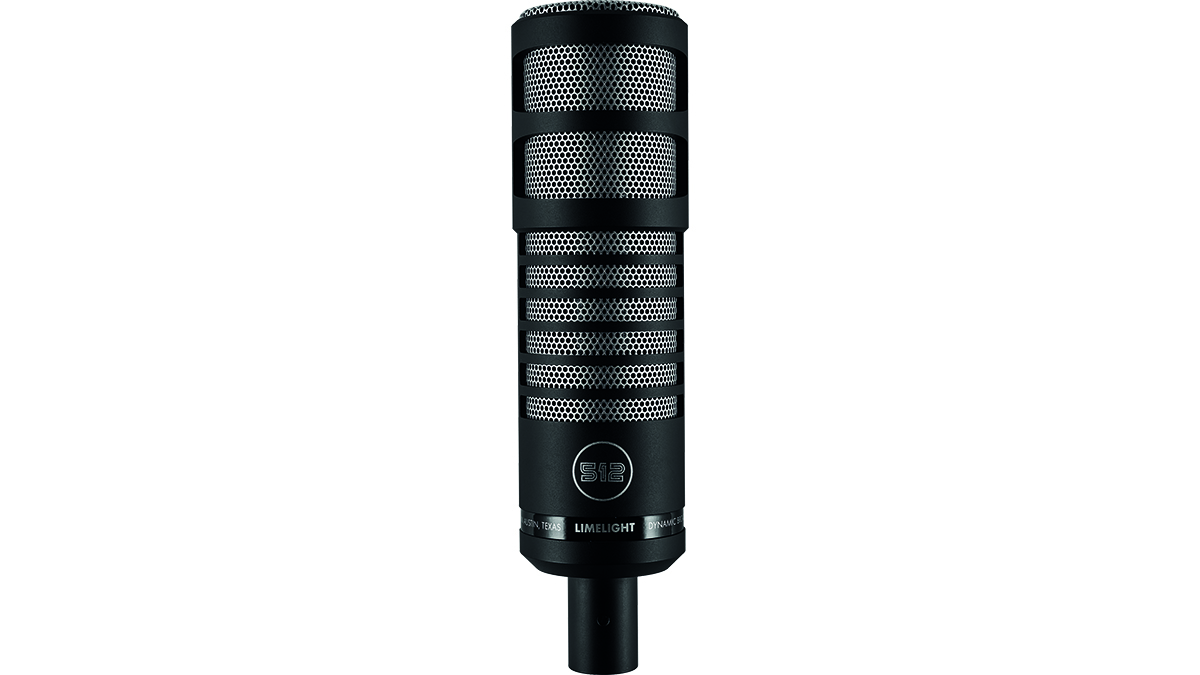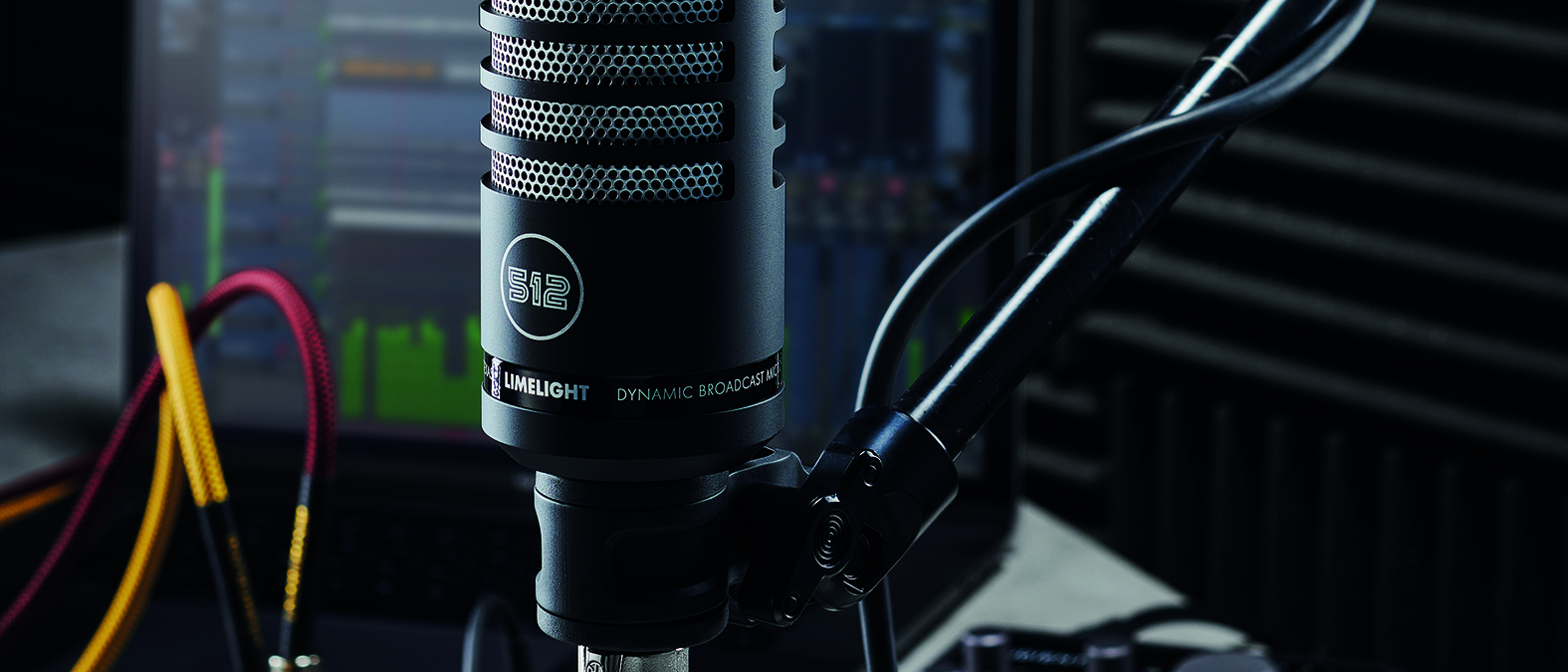MusicRadar Verdict
Easy-to-use, affordable mic for podcasters/YouTubers that bathes voices in a dose of Southern warmth. Just don’t get too close.
Pros
- +
Specifically voiced for broadcast.
- +
Warmth.
- +
Simplicity itself.
- +
Light weight.
- +
Good value.
Cons
- -
Boominess when close-miked.
- -
Swivel mount obscures filter switch.
- -
No internal pop filter.
MusicRadar's got your back
512 Audio Limelight: What is it?
512 Audio is the new sibling of Texas-based Warm Audio, with a remit to bring the same healthy quality/price ratio but with a product range developed for pro/am creators. This is where the Limelight hypercardioid dynamic mic fits in. It’s one of just two launch microphones squarely aimed at podcasters and YouTubers; the other is its Skylight studio condenser.
Despite having a name more suited to stage performance, the Limelight has been developed to be a fuss-free voice mic that will make your podcast or stream sound good wherever you’re creating it. This is the Holy Grail for amateur creators, who rarely have the luxury of a professionally treated studio to broadcast from, and who possess next to no technical know-how.

It is certainly a handsome-looking piece of kit that bears more than a slight resemblance to the iconic Electro-Voice RE20. Its matt aluminium black body and silver grilles contrast tastefully with the gloss logo band that proudly declares ‘Designed in Austin, Texas’. It’s also a very simple beast – other than the micro-switch for the 100Hz high-pass filter there are no controls to master, just an XLR socket. Usefully, it’s supplied with a simple swivel mount and padded carry bag.
Pick the Limelight up and the first thing that strikes you is its weight. At 380g, this thing lacks heft. Is that a bad thing? We don’t think so. Its aluminium casing is solid enough, and there’s nothing to suggest it’s poorly built. If anything, those of us who choose to broadcast from different locations will appreciate being able to travel light.
512 Audio Limelight: Performance and verdict
512 Audio hasn’t yet published a frequency response curve chart for the Limelight, but the company did tell us that it has been developed to accentuate lows around 100Hz. Other than that, the response is “fairly flat”. The frequency range is 50Hz to 15kHz.
Why should we care? Well, warming up the low end should give your voice a beautifully rich quality, made more apparent by the proximity effect as you move closer to the mic. Meanwhile, the limited frequency range (a large-diaphragm condenser typically captures a broader 20Hz to 20kHz) won’t pick up unwanted deep rumble or high-frequency background noise. Factor in that this is a hypercardioid mic with a relatively narrow pickup pattern and the Limelight should do a great job of recording your voice and little else.
To test this out we abandoned the studio and set up in a small, square untreated spare room with the central heating left on. An awful environment for any mic, but a typical one for podcasters. We did make some effort to reduce reflections by scattering soft furnishings around and hanging a duvet up behind us.
We hooked up the Limelight and, for comparison, a Shure SM7B to our Sound Devices MixPre 3 mixer/recorder, which is well-respected for its quiet preamps and clean high gain. The first thing we noticed was that Limelight’s swivel mount obscures its high-pass filter switch, which makes engaging it a real faff. However, the 512 Audio engineers were right, this really is a warm sounding mic. From six to eight inches away it flatters both male and female voices sublimely, although your mileage may vary. Unwanted room noise was very well suppressed.
The more expensive SM7B is famous for making any room sound great, but in our tests, the Limelight performed equally as well. Off-axis sounds were also vanquished – a characteristic of its hypercardioid pattern – which is very useful if you work with co-hosts or guests.
Get up close and personal with the Limelight and the proximity effect becomes very apparent – suddenly we’re in ‘Smashie and Nicey’ territory! Worse, at this close distance, the Limelight exhibits a prominent boominess. Engaging the high-pass filter cures this completely but also robs us of all warmth. It’s like turning a hot tap on and off. The obvious solution is to back off a bit. Once you’ve found the sweet spot, which will vary from voice to voice, the Limelight performs beautifully.
512 Audio has produced an easy-to-use mic for creators who find themselves broadcasting in untreated rooms. Unlike the SM7B, it’s not a gain-eating monster, so it should work well with most consumer-level recorders and interfaces. It also doesn’t have the SM7B’s price tag.
The close-miked boominess is disappointing, but it shouldn’t overshadow Limelight’s otherwise sterling performance.
MusicRadar verdict: Easy-to-use, affordable mic for podcasters/YouTubers that bathes voices in a dose of Southern warmth. Just don’t get too close.
512 Audio Limelight: The web says
"A perfect introduction to Large Diaphragm Dynamics for the budding creative, with a host of application-specific features that combine to make it one of the most adept plug-n-play mics out there at the moment."
Mixdown
512 Audio Limelight: Hands-on demos
512 Audio
Podcastage
Curtis Judd
512 Audio Limelight: Specifications
- A dynamic hypercardioid microphone specifically developed and voiced for broadcast.
- WEIGHT: 379g
- DIMENSIONS: 167.5 x 60.8mm
- ACCESSORIES: Adjustable swivel mount & protective carry bag.
- CONTACT: 512 Audio
When Simon's childhood classical guitar teacher boasted he 'enjoyed a challenge', the poor man had no idea how much he'd underestimated the scale of the task ahead. Despite Simon's lack of talent, the experience did spark a lifelong passion for music. His classical guitar was discarded for an electric, then a room full of electrics before Simon discovered the joys of keys. Against all odds, Simon somehow managed to blag a career as a fashion journalist, but he's now more suitably employed writing for MusicRadar and Guitar World. When not writing or playing, he can be found terrifying himself on his mountain bike.
With its latest free update, Ableton has finally turned Note into the app I always wanted it to be
Technically capable, but struggle to make your tunes sound musical? 5 simple music theory hacks to make your tracks stand out
"Despite its size, it delivers impressive audio quality and premium functions as well as featuring a good selection of inspired sounds": Roland GO:Piano 88PX review











